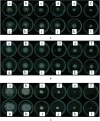AMF colonization affects allelopathic effects of Zea mays L. root exudates and community structure of rhizosphere bacteria
- PMID: 36507415
- PMCID: PMC9731342
- DOI: 10.3389/fpls.2022.1050104
AMF colonization affects allelopathic effects of Zea mays L. root exudates and community structure of rhizosphere bacteria
Abstract
Arbuscular mycorrhizal fungi (AMF) widely exist in the soil ecosystem. It has been confirmed that AMF can affect the root exudates of the host, but the chain reaction effect of changes in the root exudates has not been reported much. The change of soil microorganisms and soil enzyme vigor is a direct response to the change in the soil environment. Root exudates are an important carbon source for soil microorganisms. AMF colonization affects root exudates, which is bound to have a certain impact on soil microorganisms. This manuscript measured and analyzed the changes in root exudates and allelopathic effects of root exudates of maize after AMF colonization, as well as the enzymatic vigor and bacterial diversity of maize rhizosphere soil. The results showed that after AMF colonization, the contents of 35 compounds in maize root exudates were significantly different. The root exudates of maize can inhibit the seed germination and seedling growth of recipient plants, and AMF colonization can alleviate this situation. After AMF colonization, the comprehensive allelopathy indexes of maize root exudates on the growth of radish, cucumber, lettuce, pepper, and ryegrass seedlings decreased by 60.99%, 70.19%, 80.83%, 36.26% and 57.15% respectively. The root exudates of maize inhibited the growth of the mycelia of the pathogens of soil-borne diseases, and AMF colonization can strengthen this situation. After AMF colonization, the activities of dehydrogenase, sucrase, cellulase, polyphenol oxidase and neutral protein in maize rhizosphere soil increased significantly, while the bacterial diversity decreased but the bacterial abundance increased. This research can provide a theoretical basis for AMF to improve the stubble of maize and the intercropping mode between maize and other plants, and can also provide a reference for AMF to prevent soil-borne diseases in maize.
Keywords: AMF; allelopathy; bacterial diversity; root exudates; soil enzyme vigor.
Copyright © 2022 Ma, Xie, Yang, Jing, You, Yang, Sun, Qin, Chen, Cao, Huang and Li.
Conflict of interest statement
The authors declare that the research was conducted in the absence of any commercial or financial relationships that could be construed as a potential conflict of interest.
Figures











Similar articles
-
Root exudation under maize/soybean intercropping system mediates the arbuscular mycorrhizal fungi diversity and improves the plant growth.Front Plant Sci. 2024 Jun 14;15:1375194. doi: 10.3389/fpls.2024.1375194. eCollection 2024. Front Plant Sci. 2024. PMID: 38947945 Free PMC article.
-
Chitooligosaccharides and Arbuscular Mycorrhizal fungi alleviate the damage by Phytophthora nicotianae to tobacco seedlings by inducing changes in rhizosphere microecology.Plant Physiol Biochem. 2024 Oct;215:108986. doi: 10.1016/j.plaphy.2024.108986. Epub 2024 Aug 3. Plant Physiol Biochem. 2024. PMID: 39106769
-
Arbuscular mycorrhizal fungi alter microbiome structure of rhizosphere soil to enhance maize tolerance to La.Ecotoxicol Environ Saf. 2021 Apr 1;212:111996. doi: 10.1016/j.ecoenv.2021.111996. Epub 2021 Feb 3. Ecotoxicol Environ Saf. 2021. PMID: 33545409
-
Mycorrhizae Helper Bacteria: Unlocking Their Potential as Bioenhancers of Plant-Arbuscular Mycorrhizal Fungal Associations.Microb Ecol. 2022 Jul;84(1):1-10. doi: 10.1007/s00248-021-01831-7. Epub 2021 Aug 21. Microb Ecol. 2022. PMID: 34417849 Review.
-
Roles of Arbuscular mycorrhizal Fungi as a Biocontrol Agent in the Control of Plant Diseases.Microorganisms. 2022 Jun 22;10(7):1266. doi: 10.3390/microorganisms10071266. Microorganisms. 2022. PMID: 35888985 Free PMC article. Review.
Cited by
-
Arbuscular Mycorrhizal Fungi Restored the Saline-Alkali Soil and Promoted the Growth of Peanut Roots.Plants (Basel). 2023 Sep 28;12(19):3426. doi: 10.3390/plants12193426. Plants (Basel). 2023. PMID: 37836166 Free PMC article.
-
Arbuscular mycorrhizal fungi - a natural tool to impart abiotic stress tolerance in plants.Plant Signal Behav. 2025 Dec;20(1):2525843. doi: 10.1080/15592324.2025.2525843. Epub 2025 Jul 9. Plant Signal Behav. 2025. PMID: 40630045 Free PMC article. Review.
-
Influence of Arbuscular Mycorrhizal Fungi on Nitrogen Dynamics During Cinnamomum camphora Litter Decomposition.Microorganisms. 2025 Jan 13;13(1):151. doi: 10.3390/microorganisms13010151. Microorganisms. 2025. PMID: 39858918 Free PMC article.
-
Rhizosphere microbiome regulation: Unlocking the potential for plant growth.Curr Res Microb Sci. 2024 Nov 22;8:100322. doi: 10.1016/j.crmicr.2024.100322. eCollection 2025. Curr Res Microb Sci. 2024. PMID: 39678067 Free PMC article. Review.
References
-
- Adedokun E. O., Rather I. A., Bajpai V. K., Park Y. (2016). Biocontrol efficacy of lactobacillus fermentum yml014 against food spoilage moulds using the tomato puree model. Front. Life Sci. 9 (1), 64–68. doi: 10.1080/21553769.2015.1084951 - DOI
-
- Bowles T. M., Acosta-Martínez V., Calderón F., Jackson L. E. (2014). Soil enzyme activities, microbial communities, and carbon and nitrogen availability in organic agroecosystems across an intensively-managed agricultural landscape. Soil Biol. Biochem. 68, 252–262. doi: 10.1016/j.soilbio.2013.10.004 - DOI
LinkOut - more resources
Full Text Sources

